Copper Sulfide Remobilization and Mineralization during Paleoproterozoic Retrograde Metamorphism in the Tongkuangyu Copper Deposit, North China Craton
Abstract
:1. Introduction
2. Regional Geology
3. Deposit Geology
3.1. General Aspect
3.2. Metamorphic and Alteration Petrography
4. Materials and Methods
4.1. Zircon U-Pb Dating
4.2. Electron Probe Microanalysis
4.3. H-O-S-Pb Isotopes
4.4. He-Ar Isotopes
5. Results
5.1. Geochronology
5.1.1. Zircon U-Pb Dating
5.1.2. Sulfide Pb-Pb Dating
5.2. Mineral Chemistry
5.2.1. Biotite
5.2.2. Chlorite
5.2.3. Sulfides
5.3. Stable Isotopes
5.3.1. H-O Isotopes
5.3.2. He-Ar Isotopes
5.3.3. Sulfur Isotopes
6. Discussion
6.1. Timing of Copper Mineralization and its Relation to Metamorphism
6.2. Origin of the Biotite and Chlorite
6.3. Sources of Ore-Forming Fluids and Copper
6.4. A Remobilization Model and Implication for Regional Metallogeny
7. Conclusions
Supplementary Materials
Author Contributions
Funding
Acknowledgments
Conflicts of Interest
References
- Sun, W.D.; Zhang, L.P.; Guo, J.; Li, C.Y.; Jiang, Y.H.; Zartman, R.E.; Zhang, Z.F. Origin of the mysterious Yin-Shang bronzes in China indicated by lead isotopes. Sci. Rep. 2016, 6, 23304. [Google Scholar] [CrossRef]
- Wang, Z.; Wen, G. Zhongtiao mountain-style porphyry deposits. Acta Geol. Sin. 1957, 37, 401–415, (In Chinese with Russian Abstract). [Google Scholar]
- Xie, J.R. Problems pertaining to geology and ore deposits of a copper deposits in Shansi province. Sci. Sin. 1963, 12, 1345–1356. [Google Scholar]
- Sun, H.T.; Ge, C.H.; Ji, S.K. Tourmaline from the Zhongtiaoshan copper metallogenic area: Its characteristics and indication significance for ore-forming process of that area. Acta Petrol. Miner. 1989, 8, 232–242, (In Chinese with English Abstract). [Google Scholar]
- CGGCDZM (Compilation group of the Geology of Copper Deposits of the Zhongtiao mountains). Geology of Copper Deposits in the Zhongtiao Mountains; Geological Publishing House: Beijing, China, 1978; pp. 1345–1356. (In Chinese) [Google Scholar]
- Xu, W.X.; Guo, X.S.; Ji, S.K.; Lu, J.R.; Li, S.P. Geochemstry study of Tongkuangyu Cu deposit. Miner. Resour. Geol. 1995, 9, 77–86. (In Chinese) [Google Scholar]
- Chen, W.M.; Li, S.P. Rhenium–osmium isotopic ages of sulfides from the Tongkuangyu porphyry copper deposit in the Zhongtiao mountain. Miner. Depos. 1998, 17, 224–228, (In Chinese with English Abstract). [Google Scholar]
- Li, N.B.; Luo, Y.; Jiang, Y.H.; Guo, S.L.; Niu, H.C. Zircon U–Pb geochronology and Hf isotopic characteristic of metamorphic quartz-monzonite porphyry from Tongkuangyu area, Zhongtiao mountain and their geological implications. Acta Petrol. Sin. 2013, 29, 2416–2424, (In Chinese with English Abstract). [Google Scholar]
- Jiang, Y.; Niu, H.; Bao, Z.; Li, N.; Shan, Q.; Yang, W. Fluid evolution of the Tongkuangyu porphyry copper deposit in the Zhongtiaoshan region: Evidence from fluid inclusions. Ore Geol. Rev. 2014, 63, 498–509. [Google Scholar] [CrossRef]
- Liu, X.; Fan, H.R.; Santosh, M.; Yang, K.F.; Qiu, Z.J.; Hu, F.F.; Wen, B.J. Geological and geochronological constraints on the genesis of the giant Tongkuangyu Cu deposit (Palaeoproterozoic), North China Craton. Int. Geol. Rev. 2016, 58, 155–170. [Google Scholar] [CrossRef]
- Liu, X.; Fan, H.R.; Yang, K.F.; Qiu, Z.J.; Hu, F.F.; Zhu, X.Y. Geochronology, redox-state and origin of the ore-hosting porphyry in the Tongkuangyu Cu deposit, North China Craton: Implications for metallogenesis and tectonic evolution. Precambrian Res. 2016, 276, 211–232. [Google Scholar] [CrossRef]
- Qiu, Z.J.; Fan, H.R.; Liu, X.; Wen, B.J.; Hu, F.F.; Yang, K.F.; Guo, S.L.; Zhao, F.C. Fluid Inclusion and Carbon-Oxygen Isotope Studies of the Hujiayu Cu Deposit, Zhongtiao mountains, China: Implications for syn-metamorphic Copper Remobilization. Acta Geol. Sin. Engl. Ed. 2015, 89, 726–745. [Google Scholar] [CrossRef]
- Qiu, Z.; Fan, H.; Liu, X.; Yang, K.; Hu, F.; Xu, W.; Wen, B. Mineralogy, chalcopyrite Re-Os geochronology and sulfur isotope of the Hujiayu Cu deposit in the Zhongtiao mountains, North China Craton: Implications for a Paleoproterozoic metamorphogenic copper mineralization. Ore Geol. Rev. 2016, 78, 252–267. [Google Scholar] [CrossRef]
- Qiu, Z.; Fan, H.; Liu, X.; Yang, K.; Hu, F.; Cai, Y. Metamorphic PTt evolution of Paleoproterozoic schist-hosted Cu deposits in the Zhongtiao mountains, North China Craton: Retrograde ore formation during sluggish exhumation. Precambrian Res. 2017, 300, 59–77. [Google Scholar] [CrossRef]
- Zhao, G.C.; Sun, M.; Wilde, S.A.; Li, S.Z. Late Archean to Paleoproterozoic evolution of the North China Craton: Key issues revisited. Precambrian Res. 2005, 136, 177–202. [Google Scholar] [CrossRef]
- Xu, Q. Study on the Geological Characteristics and Ore Genesis of Tongkuangyu Copper Deposit in the Zhongtiaoshan Mountains, Shanxi Province. Master’s Thesis, Jilin University, Changchun, China, 2010; p. 117, (In Chinese with English Abstract). [Google Scholar]
- Sun, D.Z.; Li, H.M.; Lin, Y.X.; Zhou, H.F.; Zhao, F.Q.; Tang, M. Precambrian geochronology, chronotectonic framework and model of chronocrustal structure of the Zhongtiao mountains. Acta Geol. Sin. 1991, 3, 216–2316, (In Chinese with English Abstract). [Google Scholar]
- Liu, X.; Fan, H.; Qiu, Z.; Yang, K.; Hu, F.; Wen, B. Formation ages of the Jiangxian and Zhongtiao groups in the Zhongtiao mountain region, North China Craton: Insights from SIMS U-Pb dating on zircons from intercalated plagioclase amphibolites. Acta Petrol. Sin. 2015, 6, 1564–1572, (In Chinese with English Abstract). [Google Scholar]
- Zhao, F. Geochronologic and Geochemical Constraints on the Paleoproterozoic Crustal Evolution of Zhongtiao Mountains from Shanxi Province. Ph.D. Thesis, China University of Geosciences, Beijing, China, 2006; p. 172, (In Chinese with English Abstract). [Google Scholar]
- Hu, W.; Sun, D. Mineralization and evolution of the early Proterozoic copper deposits in the Zhongtiao mountains. Acta Geol. Sin. 1987, 2, 152–165, (In Chinese with English Abstract). [Google Scholar]
- Liu, C.; Zhao, G.; Sun, M.; Zhang, J.; Yin, C. U–Pb geochronology and Hf isotope geochemistry of detrital zircons from the Zhongtiao Complex: Constraints on the tectonic evolution of the Trans-North China Orogen. Precambrian Res. 2012, 222–223, 159–172. [Google Scholar] [CrossRef]
- Liu, S.; Liu, C.; Li, Q.; Lü, Y.; Yu, S.; Tian, W.; Feng, Y. EPMA Th-U-Pb monazite dating of Zhongtiao and Lüliang Precambrian metamorphic complexes. Front. Earth Sci. 2007, 14, 64–74, (In Chinese with English Abstract). [Google Scholar] [CrossRef]
- Jiang, Y.; Niu, H.; Bao, Z.; Li, N.; Shan, Q.; Yang, W.; Yan, S. Fluid evolution of the Paleoproterozoic Hujiayu copper deposit in the Zhongtiaoshan region: Evidence from fluid inclusions and carbon–oxygen isotopes. Precambrian Res. 2014, 255, 734–747. [Google Scholar] [CrossRef]
- Zhao, Y.; Li, N.; Jiang, Y.; Niu, H.; Yang, W. Multi-stage Cu remobilization of the Huping metamorphic- hydrothermal deposit in the southern North China Craton. Ore Geol. Rev. 2018, 101, 870–884. [Google Scholar] [CrossRef]
- Hu, Y. Mineralization and ore prognosis of the Tongkuangyu meta-porphyry copper deposit. Miner. Depos. 2000, 19, 46–53, (In Chinese with English Abstract). [Google Scholar]
- Cui, C.X.; Zhen, Y.Q. Geology, alteration and metallogenesis of giant Tongkuangyu porphyry copper deposit in Zhongtiaoshan area. Contrib. Geol. Miner. Resour. Res. 2013, 28, 1–11, (In Chinese with English Abstract). [Google Scholar]
- Wiedenbeck, M.; Alle, P.; Corfu, F.; Griffin, W.L.; Meier, M.; Oberli, F.; Quadt, A.V.; Roddick, J.C.; Spiegel, W. Three natural zircon standards for U-Th-Pb, Lu-Hf, trace element and REE analyses. Geostand Geoanal. Res. 1995, 19, 1–23. [Google Scholar] [CrossRef]
- Sláma, J.; Košler, J.; Condon, D.J.; Crowley, J.L.; Gerdes, A.; Hanchar, J.M.; Whitehouse, M.J. Plešovice zircon-a new natural reference material for U-Pb and Hf isotopic microanalysis. Chem. Geol. 2008, 249, 1–356. [Google Scholar] [CrossRef]
- Liu, Y.; Gao, S.; Hu, Z.; Gao, C.; Zong, K.; Wang, D. Continental and oceanic crust recycling-induced melt-peridotite interactions in the Trans-North China Orogen: U-Pb dating, Hf isotopes and trace elements in zircons of mantle xenoliths. J. Petrol. 2010, 51, 537–571. [Google Scholar] [CrossRef]
- Ludwig, K.R. User’s manual for Isoplot 3.00. A geochronological Toolkit for Microsoft Excel. Berkeley Geochronol. Cent. Spec. Publ. 2003, 4, 25–32. [Google Scholar]
- He, H.; Zhu, R.; Saxton, J. Noble gas isotopes in corundum and peridotite xenoliths from the eastern North China Craton: Implication for comprehensive refertilization of lithospheric mantle. Phys. Earth Planet. Inter. 2011, 189, 185–191. [Google Scholar] [CrossRef]
- Burnard, P.; Hu, R.Z.; Turner, G.; Bi, X.W. Mantle, crustal and atmospheric noble gases in ailaoshan gold deposits, Yunnan Province, China. Geochim. Cosmochim. Acta 1999, 632, 1595–1604. [Google Scholar] [CrossRef]
- White, W.M. Isotope Geochemistry; John Wiley and Sons: Hoboken, NJ, USA, 2015; ISBN 978-0470656709. [Google Scholar]
- Xu, W.X.; Wang, L.M.; Li, H.; Guo, X.S. Isotope geochemistry of copper deposits in the Zhongtiao mountain. Acta Geosci. Sin. 2005, 26, 130–133, (In Chinese with English Abstract). [Google Scholar]
- Sangster, D.F. Mississippi Valley-type and SEDEX lead-zinc deposits: A comparative examination. Inst. Min. Metall. Trans. Sect. B Appl. Earth Sci. 1990, 99, 21–42. [Google Scholar] [CrossRef]
- Panneerselvam, K.; Macfarlane, A.W.; Salters, V.J. Reconnaissance Lead isotope characteristics of the Blackbird deposit: Implications for the age and origin of cobalt-copper mineralization in the Idaho Cobalt Belt, United States. Econ. Geol. 2012, 107, 1177–1188. [Google Scholar] [CrossRef]
- Wu, C.; Chen, H. Revised Ti-in-biotite geothermometer for ilmenite-or rutile-bearing crustal metapelites. Sci. Bull. 2015, 60, 116–121. [Google Scholar] [CrossRef]
- Cathelineau, M.; Izquierdo, G. Temperature-composition relationships of authigenic micaceous minerals in the Los Azufres geothermal system. Contrib. Mineral. Petrol. 1988, 100, 418–428. [Google Scholar] [CrossRef]
- Jowett, E.C. Fitting iron and magnesium into the hydrothermal chlorite geothermometer. In Proceedings of the GAC/MAC/SEG Joint Annual Meeting, Toronto, ON, Canada, 27–29 May 1991; Program with Abstracts 16. Volume 16, p. A62. [Google Scholar]
- Suzuoki, T.; Epstein, S. Hydrogen isotope fractionation between OH-bearing minerals and water. Geochim. Cosmochim. Acta 1976, 40, 1229–1240. [Google Scholar] [CrossRef]
- Javoy, M. Stable isotopes and geothermometry. J. Geol. Soc. Lond. 1977, 133, 609–636. [Google Scholar] [CrossRef]
- Cole, D.R.; Ripley, E.M. Oxygen isotope fractionation between chlorite and water from 170 to 350 °C: A preliminary assessment based on partial exchange and fluid/rock experiments. Geochim. Cosmochim. Acta 1999, 63, 449–457. [Google Scholar] [CrossRef]
- Clayton, R.N.; O’Neil, J.R. Mayeda TK. Oxygen isotope exchange between quartz and water. J. Geophys. Res. 1972, 77, 3057–3067. [Google Scholar] [CrossRef]
- Kouzmanov, K.; Pettke, T.; Heinrich, C.A. Direct analysis of ore-precipitating fluids: Combined IR microscopy and LA-ICP-MS study of fluid inclusions in opaque ore minerals. Econ. Geol. 2010, 105, 351–373. [Google Scholar] [CrossRef]
- Zhu, M.T.; Zhang, L.C.; Wu, G.; He, H.Y.; Cui, M.L. Fluid inclusions and He-Ar isotopes in pyrite from the Yinjiagou deposit in the southern margin of the North China Craton: A mantle connection for poly-metallic mineralization. Chem. Geol. 2013, 351, 1–14. [Google Scholar] [CrossRef]
- Lüders, V. Contribution of infrared microscopy to studies of fluid inclusions hosted in some opaque ore minerals: Possibilities, limitations, and perspectives. Mineral. Deposit. 2017, 52, 663–673. [Google Scholar] [CrossRef]
- Winckler, G.; Aeschbach-Hertig, W.; Kipfer, R.; Botz, R.; Rübel, A.P.; Bayer, R.; Stoffers, P. Constraints on origin and evolution of Red Sea brines from helium and argon isotopes. Earth Planet. Sci. Lett. 2001, 184, 184. [Google Scholar] [CrossRef]
- Kendrick, M.A.; Burnard, P. Noble gases and halogens in fluid inclusions: A journey through the Earth’s crust. In The Noble Gases as Geochemical Tracers; Springer: Berlin, Germany, 2013; pp. 319–369. ISBN 978-3-642-28835-7. [Google Scholar]
- Sun, H.T.; Sun, J.G.; Xie, K.Q.; Yang, L.; Yin, W.D.; Xue, S.S. Ore-forming fluids and stable isotopes of the Tongkuangyu porphyry Cu deposit, Zhongtiao mountain. Acta Geol. Sin. 2015, 89, 151–153. (In Chinese) [Google Scholar]
- Zhang, L.; Li, B.; Zhang, H.; Hu, A. Re-Os isotopic dating and its significance of molybdenite from the Tongmugou Cu deposit, Zhongitaoshan, Shanxi. Glob. Geol. 2013, 32, 740–7466, (In Chinese with English Abstract). [Google Scholar]
- Qian, J.; Wei, C.; Zhou, X.; Zhang, Y. Metamorphic P–T paths and New Zircon U–Pb age data for garnet–mica schist from the Wutai group, North China Craton. Precambrian Res. 2013, 2332, 282–296. [Google Scholar] [CrossRef]
- Sun, J.G.; Li, H.Y.; Liu, X.H.; Xie, K.Q.; Li, B.L.; Yin, D.W. Alteration and mineralization characteristics of Tongkuangyu copper deposit in Zhongtiao mountain, Shanxi Province. Min. Depos. 2014, 33, 1306–1324, (In Chinese with English Abstract). [Google Scholar]
- Nachit, H.; Ibhi, A.; Abia, E.H.; Ohoud, M.B. Discrimination between primary magmatic biotites, reequilibrated biotites and neoformed biotites. CR Geosci. 2005, 337, 1415–1420. [Google Scholar] [CrossRef]
- Gokhale, N.W. Chemical composition of biotites as a guide to ascertain the origin of granites. Bull. Geol. Soc. Finl. 1968, 40, 107–111. [Google Scholar] [CrossRef]
- Goldfarb, R.J. Gold deposits in metamorphic rocks of Alaska. Econ. Geol. Monogr. 1997, 9, 151–190. [Google Scholar] [CrossRef]
- Goldfarb, R.J.; Groves, D.I. Orogenic gold: Common or evolving fluid and metal sources through time. Lithos 2015, 233, 2–26. [Google Scholar] [CrossRef]
- Hu, R.; Burnard, P.G.; Turner, G.; Bi, X. Helium and argon isotope systematics in fluid inclusions of Machangqing copper deposit in west Yunnan Province, China. Chem. Geol. 1998, 146, 55–63. [Google Scholar] [CrossRef]
- Mamyrin, B.A.; Tolstikhin, I.N. Helium Isotopes in Nature; Elsevier: Amsterdam, The Netherlands, 1984; 273p, ISBN 9781483289809. [Google Scholar]
- Palin, R.M.; White, R.W.; Green, E.C. Partial melting of metabasic rocks and the generation of tonalitic–trondhjemitic–granodioritic (TTG) crust in the Archaean: Constraints from phase equilibrium modelling. Precambrian Res. 2016, 287, 73–90. [Google Scholar] [CrossRef]
- White, R.W.; Palin, R.M.; Green, E.C. High-grade metamorphism and partial melting in Archean composite grey gneiss complexes. J. Metamorph. Geol. 2017, 12, 1345–1356. [Google Scholar] [CrossRef]
- Asadi, S.; Moore, F.; Fattahi, N. Fluid inclusion and stable isotope constraints on the genesis of the Jian copper deposit, Sanandaj–Sirjan metamorphic zone, Iran. Geofluids 2013, 13, 66–81. [Google Scholar] [CrossRef]
- Heimann, A.; Spry, P.G.; Teale, G.S.; Leyh, W.R.; Conor, C.H.; Mora, G.; O’Brien, J.J. Geochemistry and genesis of low-grade metasediment-hosted Zn-Pb-Ag mineralization, southern Proterozoic Curnamona Province, Australia. J. Geochem. Explor. 2013, 128, 97–116. [Google Scholar] [CrossRef]
- Yardley, B.; Gleeson, S.; Bruce, S.; Banks, D. Origin of retrograde fluids in metamorphic rocks. J. Geochem. Explor. 2000, 69, 281–285. [Google Scholar] [CrossRef]
- Li, G.; Peacor, D.R.; Essene, E.J. The formation of sulfides during alteration of biotite to chlorite-corrensite. Clay Clay Miner. 1998, 46, 649–657. [Google Scholar] [CrossRef]
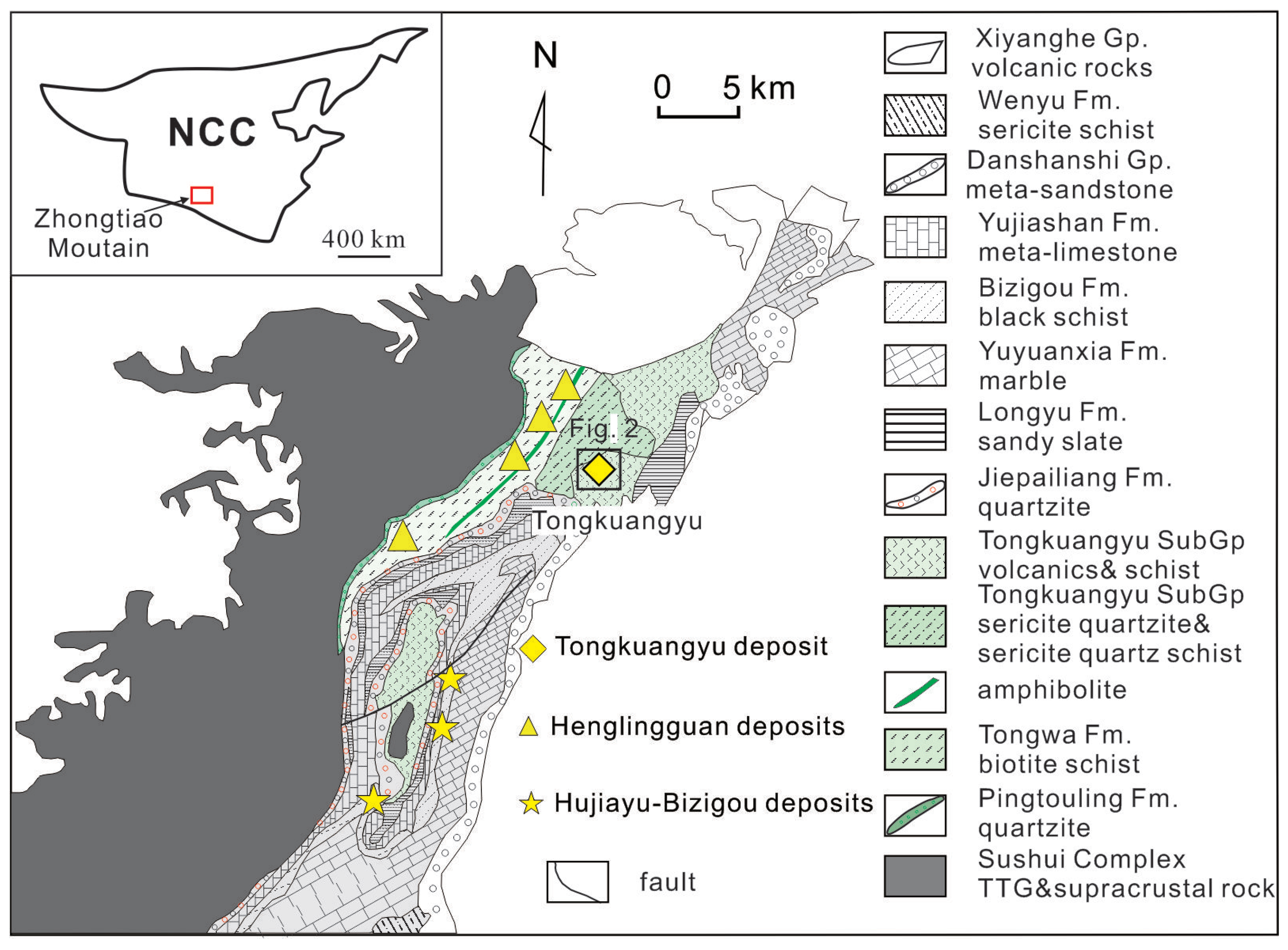
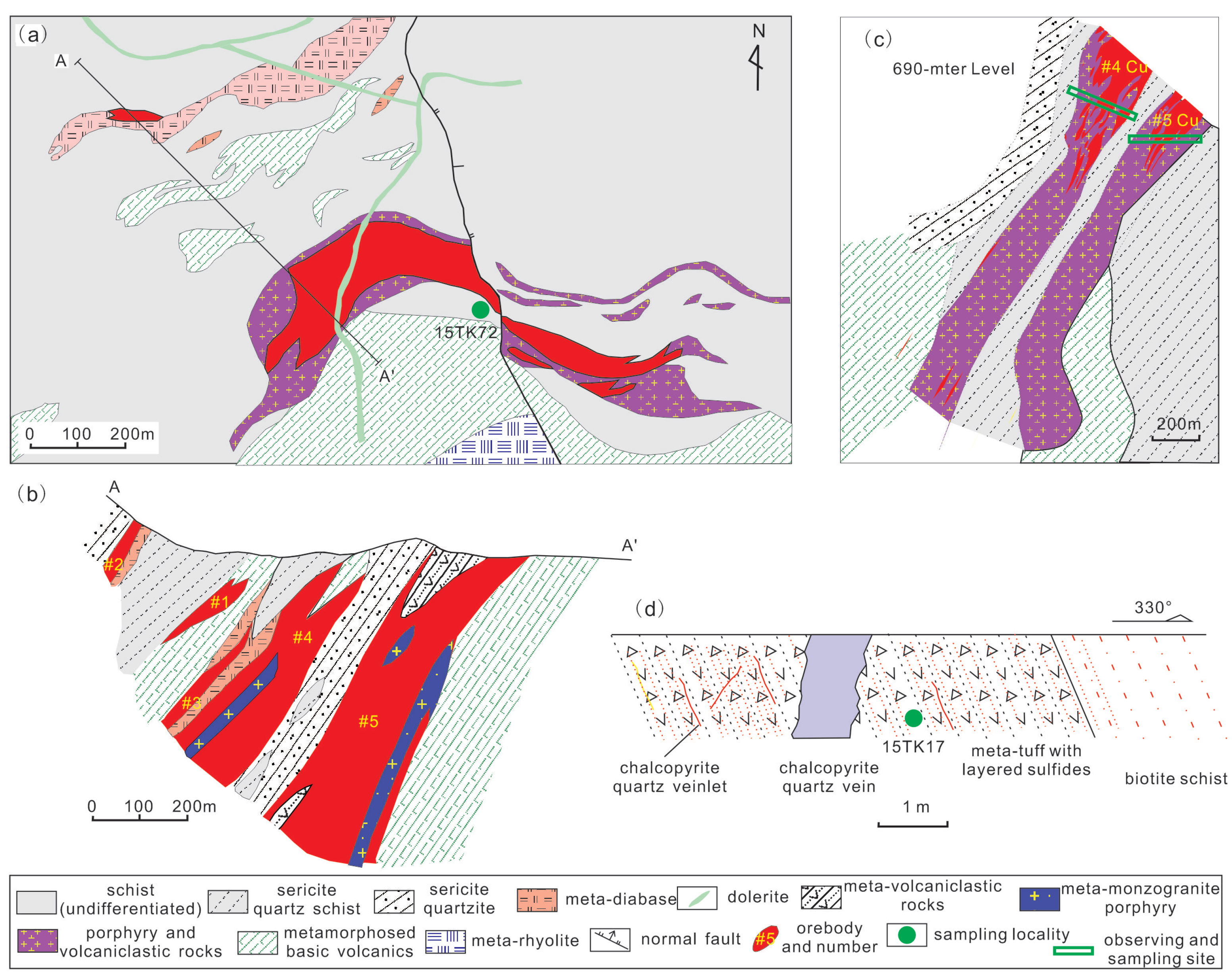
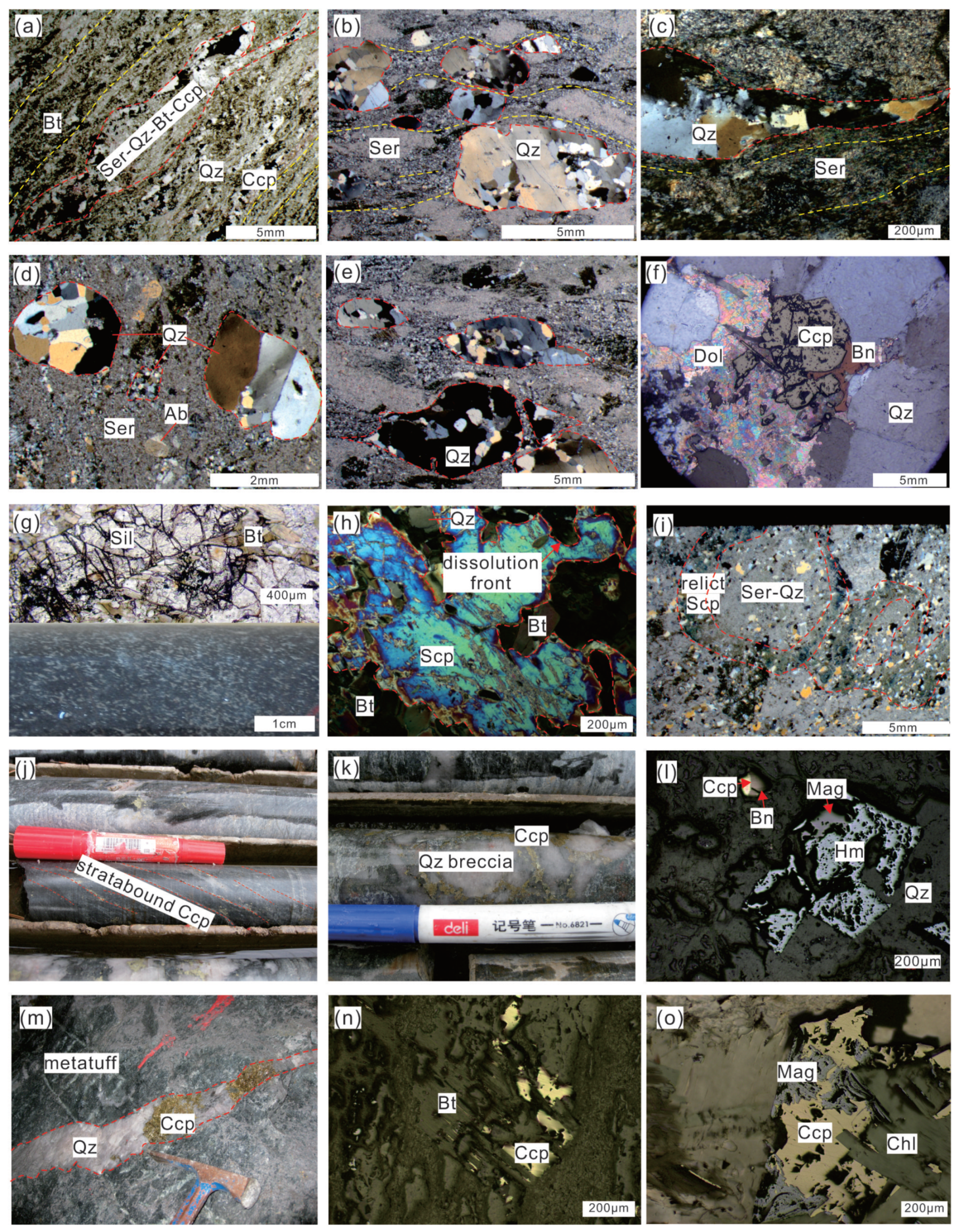
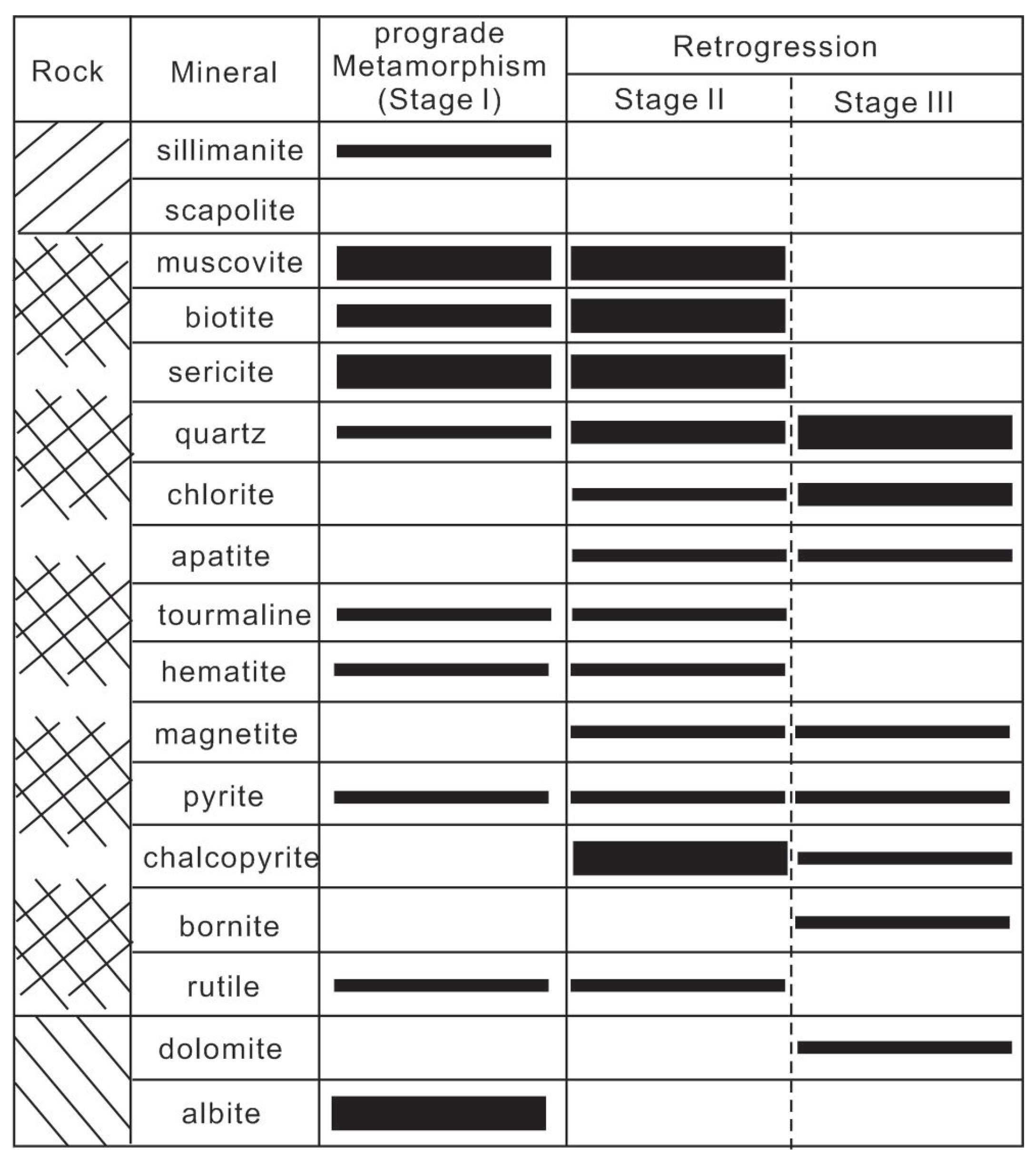
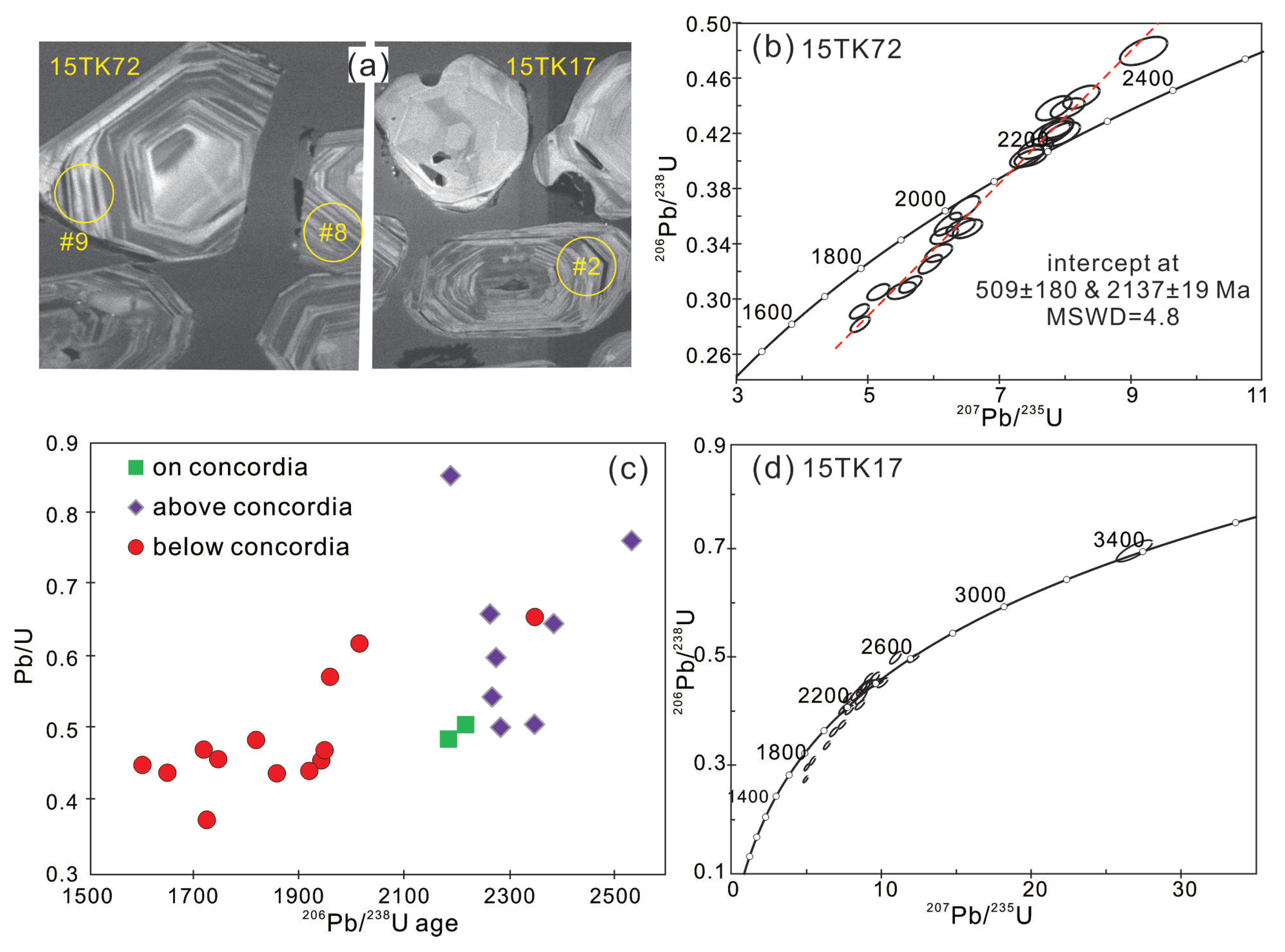
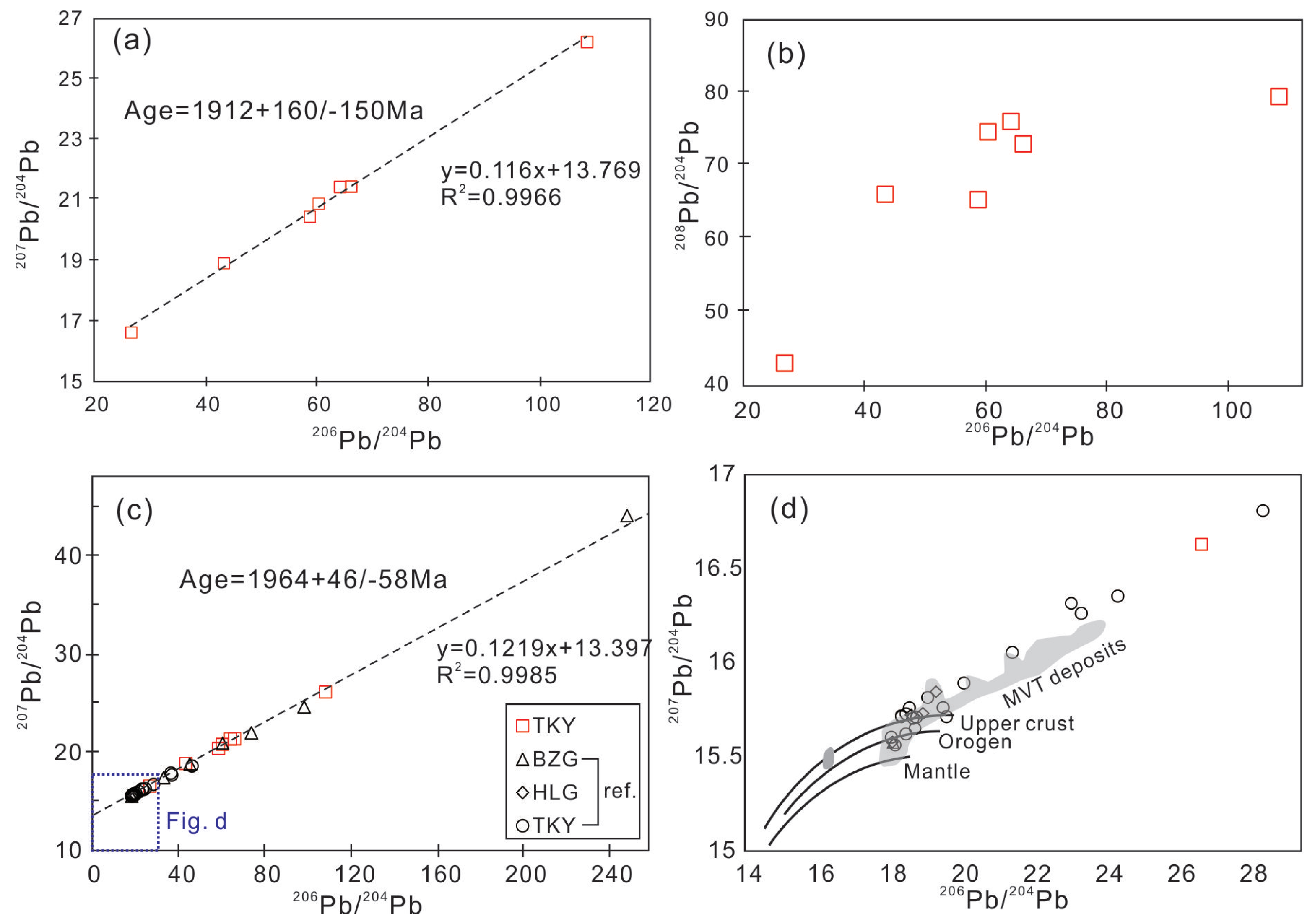
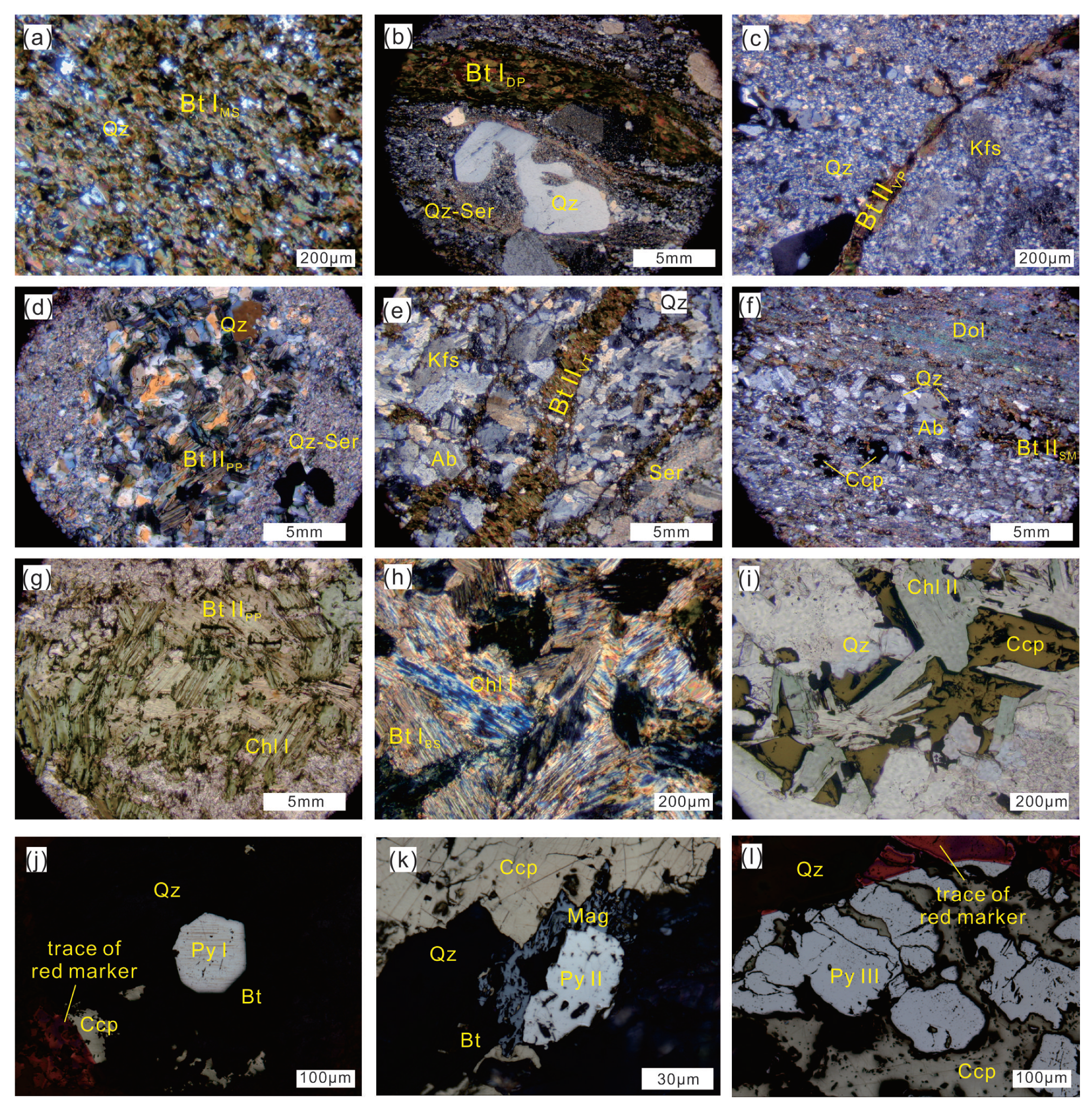
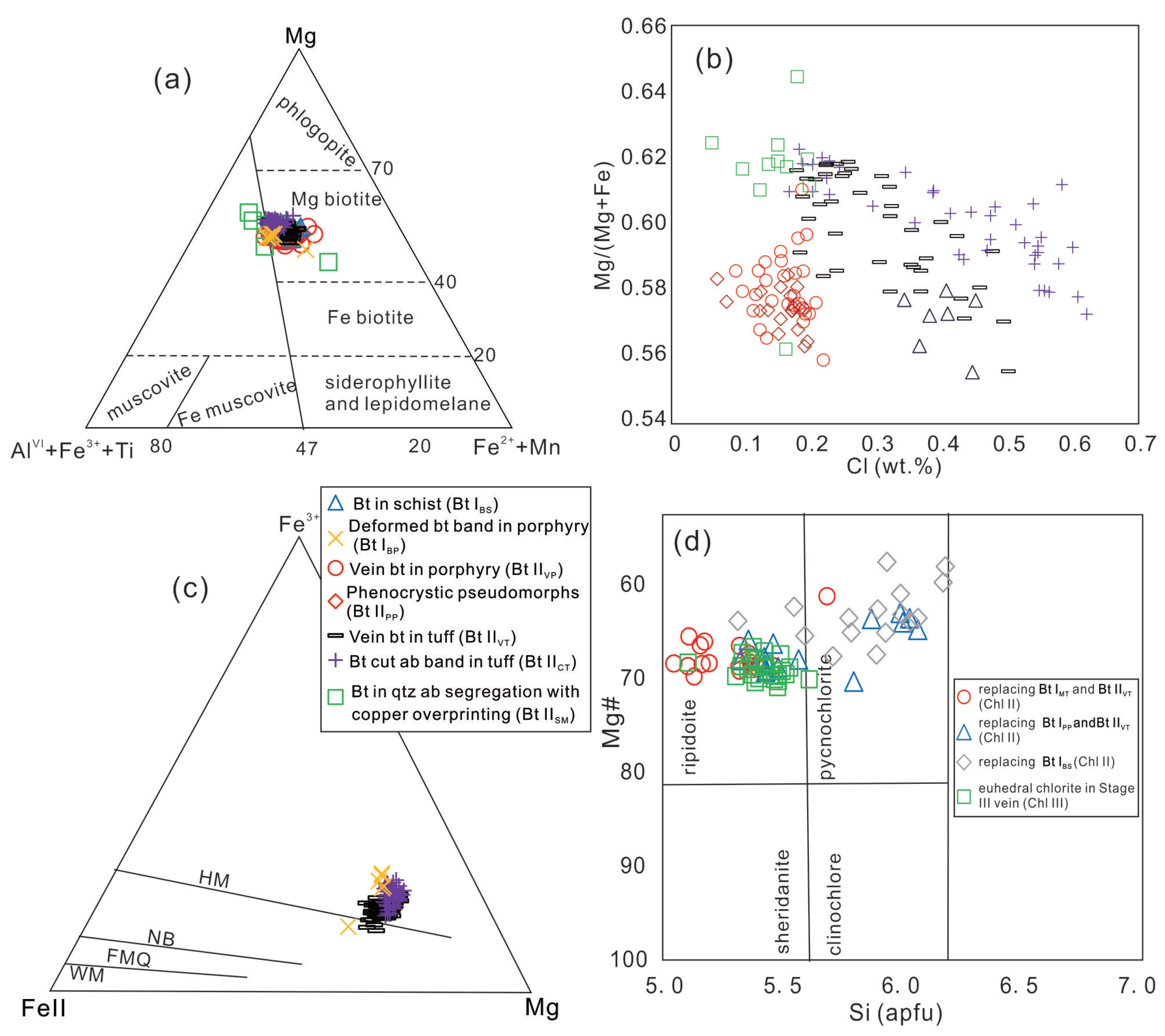

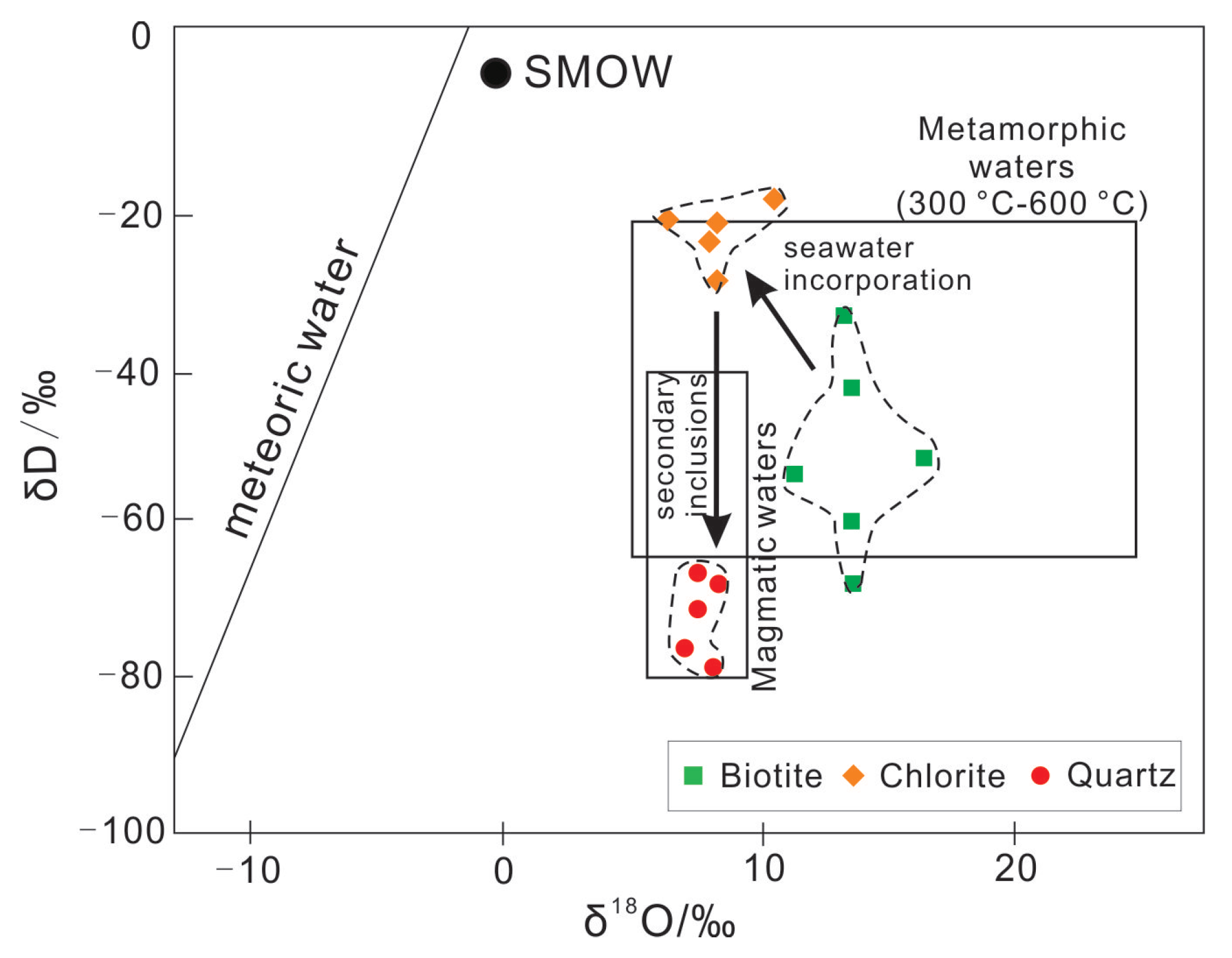

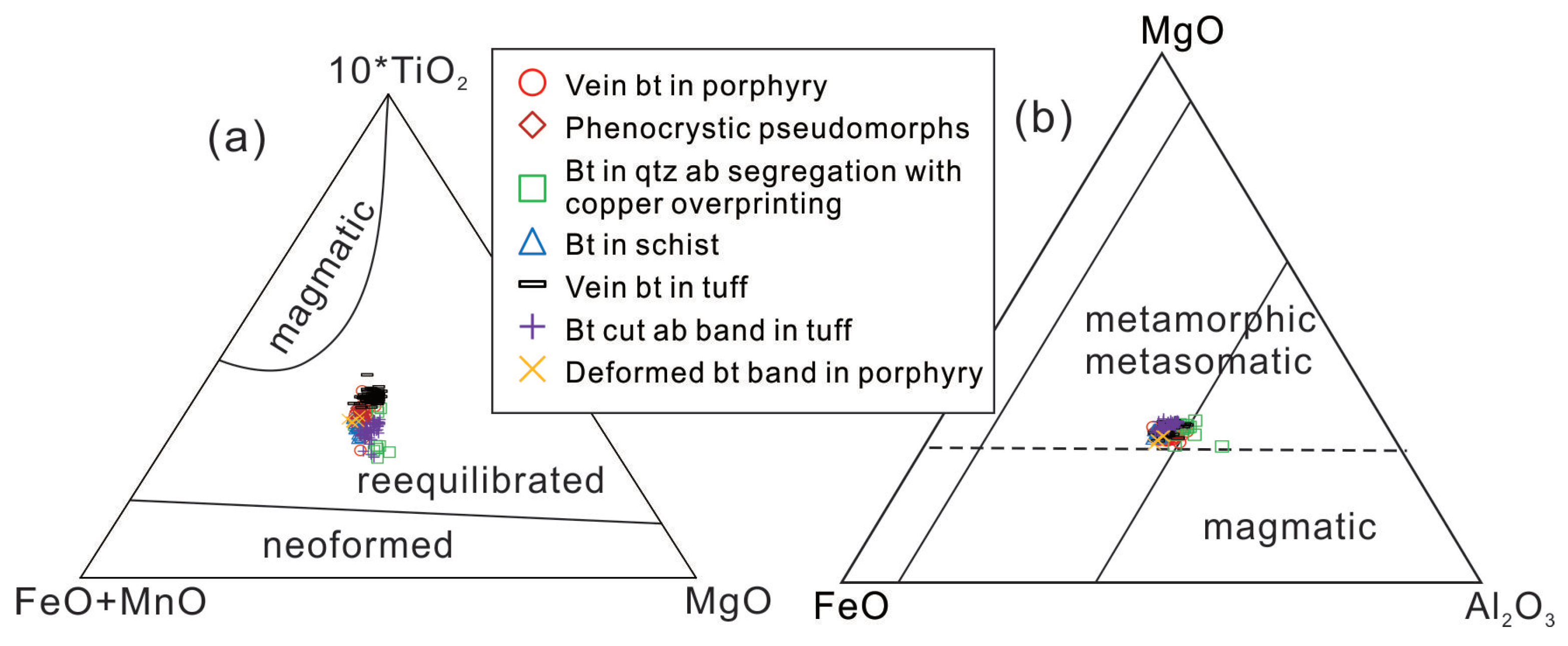
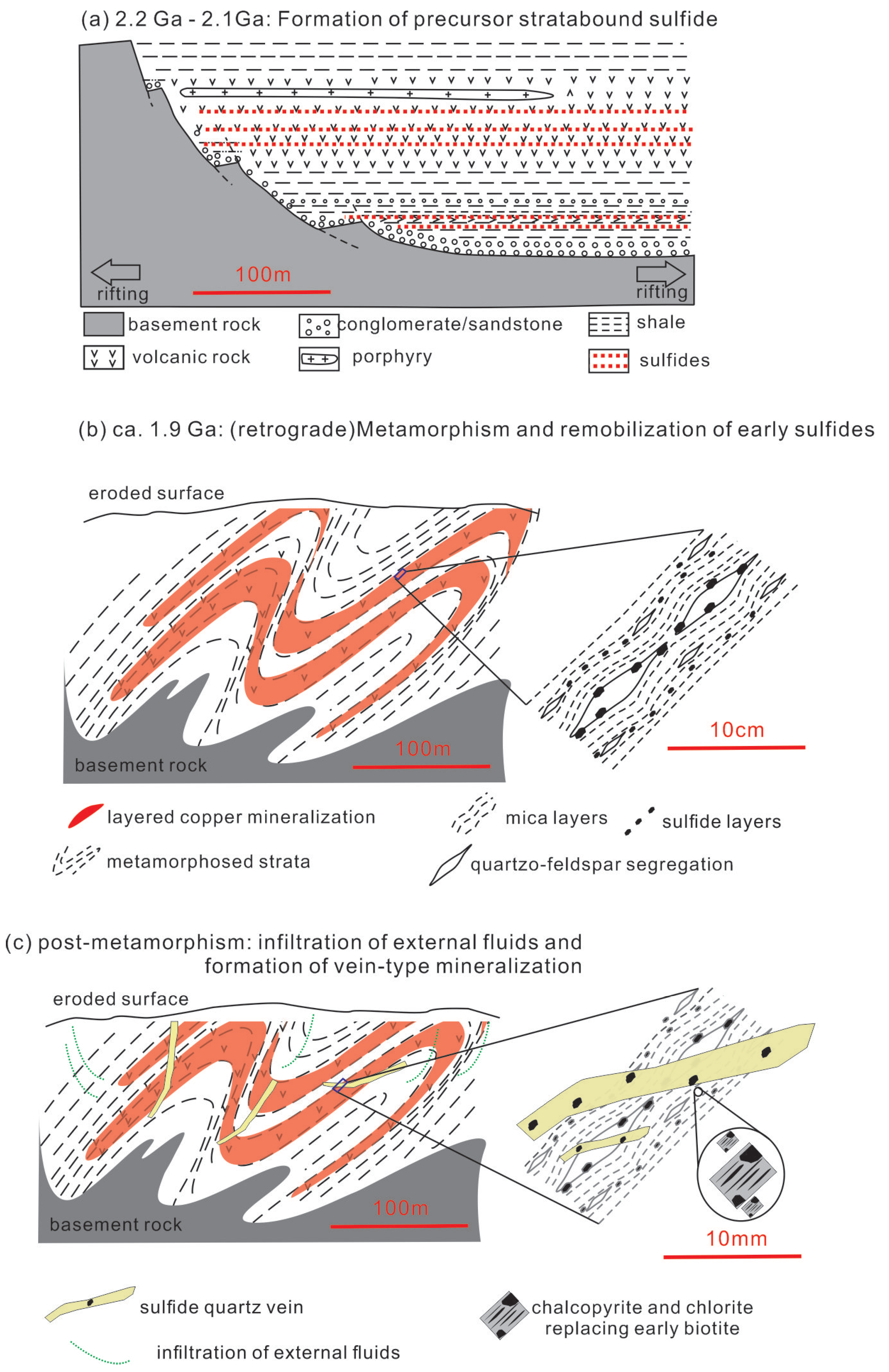
| Th | U | Pb/Pb | 1 | Pb/U | 1 | Pb/U | 1 | Pb/Pb | 1 | Pb/U | 1 | Pb/U | 1 | Continued | |
|---|---|---|---|---|---|---|---|---|---|---|---|---|---|---|---|
| ppm | ppm | Ratio | Ratio | Ratio | Age (Ma) | Age (Ma) | Age (Ma) | ||||||||
| 15TK72-1 | 160 | 464 | 0.132596 | 0.003564 | 6.507720 | 0.182921 | 0.350795 | 0.005490 | 2132 | 52 | 2047 | 25 | 1938 | 26 | 94% |
| 15TK72-2 | 220 | 512 | 0.129750 | 0.003308 | 6.403430 | 0.176909 | 0.352037 | 0.005217 | 2095 | 44 | 2033 | 24 | 1944 | 25 | 95% |
| 15TK72-3 | 77.9 | 123 | 0.135365 | 0.003510 | 7.937943 | 0.228860 | 0.419388 | 0.007038 | 2169 | 45 | 2224 | 26 | 2258 | 32 | 98% |
| 15TK72-4 | 94.6 | 319 | 0.132544 | 0.003098 | 7.870702 | 0.204647 | 0.423792 | 0.005930 | 2132 | 41 | 2216 | 23 | 2278 | 27 | 97% |
| 15TK72-5 | 224 | 468 | 0.131296 | 0.003076 | 5.941478 | 0.145733 | 0.325153 | 0.005513 | 2117 | 46 | 1967 | 21 | 1815 | 27 | 91% |
| 15TK72-6 | 132 | 260 | 0.133746 | 0.003104 | 7.869795 | 0.193886 | 0.421906 | 0.005832 | 2148 | 41 | 2216 | 22 | 2269 | 26 | 97% |
| 15TK72-7 | 314 | 566 | 0.130290 | 0.002858 | 5.639331 | 0.140118 | 0.310505 | 0.004931 | 2102 | 39 | 1922 | 21 | 1743 | 24 | 90% |
| 15TK72-8 | 126 | 343 | 0.131646 | 0.003249 | 7.408248 | 0.208270 | 0.403092 | 0.006465 | 2120 | 43 | 2162 | 25 | 2183 | 30 | 99% |
| 15TK72-9 | 225 | 519 | 0.130358 | 0.003080 | 6.068570 | 0.167968 | 0.333227 | 0.005233 | 2103 | 41 | 1986 | 24 | 1854 | 25 | 93% |
| 15TK72-10 | 125 | 252 | 0.132539 | 0.003509 | 7.773304 | 0.241875 | 0.420249 | 0.007076 | 2132 | 46 | 2205 | 28 | 2262 | 32 | 97% |
| 15TK72-11 | 93.5 | 142 | 0.137270 | 0.003834 | 9.184007 | 0.293271 | 0.479612 | 0.008367 | 2194 | 50 | 2357 | 29 | 2526 | 36 | 93% |
| 15TK72-12 | 116 | 317 | 0.129485 | 0.003851 | 5.507699 | 0.175762 | 0.306076 | 0.004994 | 2091 | 52 | 1902 | 27 | 1721 | 25 | 90% |
| 15TK72-13 | 131 | 394 | 0.133465 | 0.003393 | 7.464090 | 0.199285 | 0.402146 | 0.005006 | 2144 | 44 | 2169 | 24 | 2179 | 23 | 99% |
| 15TK72-14 | 202 | 525 | 0.127731 | 0.003130 | 6.152720 | 0.171515 | 0.346059 | 0.005146 | 2078 | 38 | 1998 | 24 | 1916 | 25 | 95% |
| 15TK72-15 | 67.3 | 227 | 0.131839 | 0.003163 | 8.029580 | 0.212421 | 0.438105 | 0.005927 | 2124 | 42 | 2234 | 24 | 2342 | 27 | 95% |
| 15TK72-16 | 88.6 | 158 | 0.133080 | 0.003169 | 8.238265 | 0.225389 | 0.446136 | 0.006850 | 2139 | 41 | 2258 | 25 | 2378 | 31 | 94% |
| 15TK72-17 | 173 | 227 | 0.126858 | 0.002816 | 6.210369 | 0.166735 | 0.354270 | 0.006768 | 2055 | 39 | 2006 | 24 | 1955 | 32 | 97% |
| 15TK72-18 | 101 | 94.3 | 0.133026 | 0.003215 | 7.544670 | 0.215092 | 0.409258 | 0.006355 | 2139 | 42 | 2178 | 26 | 2212 | 29 | 98% |
| 15TK72-19 | 502 | 689 | 0.125083 | 0.002520 | 4.874860 | 0.119185 | 0.281679 | 0.004591 | 2031 | 35 | 1798 | 21 | 1600 | 23 | 88% |
| 15TK72-20 | 66.1 | 115 | 0.129282 | 0.003252 | 7.821594 | 0.221500 | 0.438180 | 0.007175 | 2088 | 44 | 2211 | 26 | 2342 | 32 | 94% |
| 15TK72-21 | 421 | 695 | 0.120703 | 0.002398 | 4.861564 | 0.117308 | 0.291056 | 0.004287 | 1966 | 35 | 1796 | 20 | 1647 | 21 | 91% |
| 15TK72-22 | 225 | 313 | 0.127552 | 0.002724 | 6.462004 | 0.184302 | 0.366062 | 0.006952 | 2065 | 37 | 2041 | 25 | 2011 | 33 | 98% |
| 15TK72-23 | 259 | 487 | 0.122368 | 0.002789 | 5.151616 | 0.137893 | 0.304989 | 0.004782 | 1991 | 41 | 1845 | 23 | 1716 | 24 | 92% |
| 15TK17-1 | 103 | 174 | 0.138998 | 0.003799 | 8.332893 | 0.283288 | 0.431033 | 0.009173 | 2215 | 48 | 2268 | 31 | 2310 | 41 | 98% |
| 15TK17-2 | 450 | 832 | 0.121614 | 0.002785 | 5.015080 | 0.139951 | 0.296264 | 0.005185 | 1980 | 41 | 1822 | 24 | 1673 | 26 | 91% |
| 15TK17-3 | 30.5 | 1018 | 0.129512 | 0.002797 | 4.940881 | 0.134594 | 0.273926 | 0.004877 | 2091 | 38 | 1809 | 23 | 1561 | 25 | 85% |
| 15TK17-4 | 278 | 887 | 0.125591 | 0.002829 | 5.394423 | 0.164264 | 0.308019 | 0.006340 | 2039 | 39 | 1884 | 26 | 1731 | 31 | 91% |
| 15TK17-5 | 220 | 380 | 0.142210 | 0.003187 | 8.767293 | 0.233089 | 0.444142 | 0.008589 | 2254 | 38 | 2314 | 24 | 2369 | 38 | 97% |
| 15TK17-6 | 228 | 242 | 0.157593 | 0.003776 | 10.944491 | 0.315616 | 0.498572 | 0.009218 | 2431 | 41 | 2518 | 27 | 2608 | 40 | 96% |
| 15TK17-7 | 150 | 224 | 0.141281 | 0.003288 | 8.670424 | 0.266669 | 0.439483 | 0.008994 | 2243 | 41 | 2304 | 28 | 2348 | 40 | 98% |
| 15TK17-8 | 186 | 554 | 0.135390 | 0.003146 | 6.361816 | 0.181396 | 0.336660 | 0.006125 | 2169 | 40 | 2027 | 25 | 1871 | 30 | 91% |
| 15TK17-9 | 95.5 | 93.8 | 0.132500 | 0.003657 | 7.463651 | 0.243966 | 0.403018 | 0.007400 | 2131 | 53 | 2169 | 29 | 2183 | 34 | 99% |
| 15TK17-10 | 118 | 279 | 0.130789 | 0.003541 | 7.756137 | 0.238536 | 0.424231 | 0.007001 | 2109 | 47 | 2203 | 28 | 2280 | 32 | 96% |
| 15TK17-11 | 157 | 318 | 0.276175 | 0.007738 | 26.897195 | 0.978275 | 0.695829 | 0.016311 | 3342 | 44 | 3380 | 36 | 3405 | 62 | 99% |
| 15TK17-12 | 158 | 265 | 0.144044 | 0.004309 | 9.028967 | 0.296604 | 0.448769 | 0.007918 | 2276 | 52 | 2341 | 30 | 2390 | 35 | 97% |
| 15TK17-13 | 131 | 206 | 0.145893 | 0.004750 | 8.654297 | 0.318667 | 0.426837 | 0.011423 | 2298 | 55 | 2302 | 34 | 2291 | 52 | 99% |
| 15TK17-14 | 252 | 415 | 0.159669 | 0.004192 | 10.081618 | 0.290057 | 0.452187 | 0.007142 | 2454 | 44 | 2442 | 27 | 2405 | 32 | 98% |
| 15TK17-15 | 256 | 493 | 0.149101 | 0.003783 | 8.569544 | 0.253865 | 0.411300 | 0.007007 | 2336 | 49 | 2293 | 27 | 2221 | 32 | 96% |
| 15TK17-16 | 305 | 441 | 0.140788 | 0.003299 | 7.375779 | 0.206542 | 0.374953 | 0.006400 | 2237 | 40 | 2158 | 25 | 2053 | 30 | 94% |
| 15TK17-17 | 223 | 384 | 0.134921 | 0.003142 | 7.710761 | 0.195892 | 0.409955 | 0.005692 | 2165 | 40 | 2198 | 23 | 2215 | 26 | 99% |
| 15TK17-18 | 150 | 281 | 0.142554 | 0.003211 | 9.171776 | 0.237656 | 0.461026 | 0.006915 | 2258 | 39 | 2355 | 24 | 2444 | 31 | 96% |
| 15TK17-19 | 144 | 197 | 0.148710 | 0.003841 | 9.530019 | 0.282890 | 0.460601 | 0.009029 | 2331 | 44 | 2390 | 27 | 2442 | 40 | 97% |
| 15TK17-20 | 114 | 135 | 0.135560 | 0.003963 | 6.816048 | 0.215324 | 0.361343 | 0.006744 | 2172 | 50 | 2088 | 28 | 1989 | 32 | 95% |
| 15TK17-21 | 179 | 221 | 0.175285 | 0.004039 | 12.155594 | 0.302240 | 0.497735 | 0.006440 | 2609 | 38 | 2616 | 23 | 2604 | 28 | 99% |
| 15TK17-22 | 130 | 186 | 0.149743 | 0.011119 | 9.315985 | 0.676213 | 0.449482 | 0.008341 | 2343 | 127 | 2370 | 67 | 2393 | 37 | 99% |
| 15TK17-23 | 142 | 228 | 0.140824 | 0.003670 | 7.865361 | 0.226347 | 0.401870 | 0.006669 | 2239 | 46 | 2216 | 26 | 2178 | 31 | 98% |
| Sample No. | Host Rock | Mineral | Pb/ Pb | sd | Pb/Pb | sd | Pb/Pb | sd |
|---|---|---|---|---|---|---|---|---|
| 13TK30 | Metamorphosed tuff | Chalcopyrite | 79.49 | 0.031 | 26.2 | 0.01 | 108.6 | 0.041 |
| 13TK44 | Chalcopyrite quartz vein | Chalcopyrite | 65.41 | 0.016 | 20.5 | 0.005 | 58.77 | 0.014 |
| 13TK62-1 | Chalcopyrite quartz vein | Chalcopyrite | 76.05 | 0.025 | 21.4 | 0.008 | 64.19 | 0.021 |
| 13TK67 | Breciated quartz vein cemented by chalcopyrite | Chalcopyrite | 43.00 | 0.009 | 16.6 | 0.004 | 26.65 | 0.007 |
| 13TK74 | Breciated quartz vein cemented by chalcopyrite | Chalcopyrite | 74.67 | 0.018 | 20.9 | 0.005 | 60.35 | 0.014 |
| 13TK89 | Biotite schist with sulfide disseminates | Pyrite | 73.02 | 0.025 | 21.5 | 0.007 | 66.23 | 0.021 |
| 13TK90 | Chalcopyrite quartz vein | Chalcopyrite | 66.10 | 0.019 | 18.9 | 0.005 | 43.32 | 0.013 |
| Sample No. | Host Rock | Mineral | D (‰) | O (‰) | O (‰) | D (‰) |
|---|---|---|---|---|---|---|
| 13TK03 | Porphyry | Biotite | −86.5 | 8.8 | 11.3 | −54.0 |
| 13TK18 | Hem two mica qtz schist | Biotite | −75.5 | 11.0 | 13.5 | −43.0 |
| 13TK40 | Biotite schist | Biotite | −66.5 | 10.9 | 13.4 | −33.2 |
| 13TK51 | Bt ser ab quartzite | Biotite | −97.8 | 11.0 | 13.6 | −67.9 |
| 13TK53 | Qtz ab sandstone cut by bt bands | Biotite | −85.6 | 13.8 | 16.3 | −51.9 |
| 13TK55 | Deformed porphyry | Biotite | −93.0 | 11.0 | 13.5 | −60.0 |
| 13TK06 | Qtz ser tuff | Chlorite | −58.5 | 10.1 | 10.5 | −18.9 |
| 13TK07 | Qtz two mica schist | Chlorite | −63.9 | 7.6 | 8.0 | −24.3 |
| 13TK08 | Qtz 2 mica schist | Chlorite | −61.5 | 7.9 | 8.3 | −21.9 |
| 13TK85 | Chl altered biotite schist | Chlorite | −61.1 | 6.0 | 6.4 | −21.5 |
| 13TK94 | Two mica schist | Chlorite | −68.9 | 7.9 | 8.3 | −29.3 |
| 13TK30 | Qtz breccia | Quartz | −78.6 | 14 | 8.2 | |
| 13TK44 | Qtz breccia | Quartz | −68.0 | 14.2 | 8.4 | |
| 13TK62-1 | Qtz vein | Quartz | −66.6 | 13.4 | 7.6 | |
| 13TK67 | Qtz breccia | Quartz | −76.2 | 12.9 | 7.1 | |
| 13TK74 | Qtz vein | Quartz | −71.2 | 13.4 | 7.6 |
| Sample No. | Host Rock | Mineral | Weight(g) | He (EccSTP/g) | He (EccSTP/g) | He/He (Ra) | Error | Ar (E ccSTp/g) | Ar(E ccSTP/g) | Ar* (E ccSTp/g) | Ar/Ar | Error | Ar/Ar | Error |
|---|---|---|---|---|---|---|---|---|---|---|---|---|---|---|
| 13TK30 | Meta-tuff | Py | 0.5 | 872.7 | 8.0E-06 | 0.010 | 0.001 | 4.6 | 0.00152 | 4.2 | 2780 | 49.8 | 0.189 | 0.003 |
| 13TK44 | Sulfide vein | Py | 0.9 | 381.3 | 7.8E-06 | 0.023 | 0.003 | 3.7 | 0.00084 | 3.4 | 4025 | 32.6 | 0.191 | 0.003 |
| 13TK62-1 | Sulfide vein | Ccp | 0.5 | 24.0 | 4.8E-07 | 0.023 | 0.002 | 9.3 | 0.00099 | 9.0 | 8623 | 195.5 | 0.187 | 0.003 |
| 13TK67 | Sulfide vein | Py | 0.5 | 150.2 | 7.9E-07 | 0.006 | 0.001 | 5.6 | 0.00167 | 5.1 | 3067 | 34.2 | 0.182 | 0.003 |
| 13TK74 | Sulfide vein | Ccp | 0.4 | 2849.6 | 5.8E-06 | 0.002 | 0.000 | 3.4 | 0.00183 | 2.9 | 1723 | 32.7 | 0.190 | 0.003 |
| Sample No. | Host Rock | Mineral | S(‰) |
|---|---|---|---|
| 13TK30 | Metamorphosed tuff | Py | 2.3 |
| 13TK67 | Chalcopyrite quartz vein | Py | 3.1 |
| 13TK89 | Chalcopyrite quartz vein | Py | 7 |
| 13TK44 | Breciated quartz vein cemented by chalcopyrite | Ccp | 4 |
| 13TK62-1 | Breciated quartz vein cemented by chalcopyrite | Ccp | 5.1 |
| 13TK74 | Biotite schist with sulfide disseminates | Ccp | 5.7 |
| 13TK90 | Chalcopyrite quartz vein | Ccp | 6.2 |
| T04 | Chalcopyrite quartz vein | Bn | 1.2 |
| TK11 | Porphyry | Bn | 1.9 |
| TKYBN1 | Breciated quartz vein cemented by chalcopyrite and bornite | Bn | 1.5 |
© 2019 by the authors. Licensee MDPI, Basel, Switzerland. This article is an open access article distributed under the terms and conditions of the Creative Commons Attribution (CC BY) license (http://creativecommons.org/licenses/by/4.0/).
Share and Cite
Liu, X.; Yang, K.; Rusk, B.; Qiu, Z.; Hu, F.; Pironon, J. Copper Sulfide Remobilization and Mineralization during Paleoproterozoic Retrograde Metamorphism in the Tongkuangyu Copper Deposit, North China Craton. Minerals 2019, 9, 443. https://doi.org/10.3390/min9070443
Liu X, Yang K, Rusk B, Qiu Z, Hu F, Pironon J. Copper Sulfide Remobilization and Mineralization during Paleoproterozoic Retrograde Metamorphism in the Tongkuangyu Copper Deposit, North China Craton. Minerals. 2019; 9(7):443. https://doi.org/10.3390/min9070443
Chicago/Turabian StyleLiu, Xuan, Kuifeng Yang, Brian Rusk, Zhengjie Qiu, Fangfang Hu, and Jacques Pironon. 2019. "Copper Sulfide Remobilization and Mineralization during Paleoproterozoic Retrograde Metamorphism in the Tongkuangyu Copper Deposit, North China Craton" Minerals 9, no. 7: 443. https://doi.org/10.3390/min9070443
APA StyleLiu, X., Yang, K., Rusk, B., Qiu, Z., Hu, F., & Pironon, J. (2019). Copper Sulfide Remobilization and Mineralization during Paleoproterozoic Retrograde Metamorphism in the Tongkuangyu Copper Deposit, North China Craton. Minerals, 9(7), 443. https://doi.org/10.3390/min9070443




